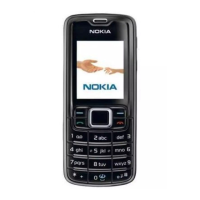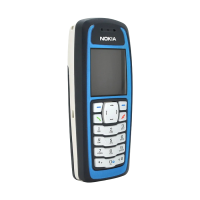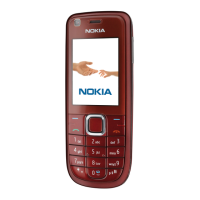Do you have a question about the Nokia 3110 and is the answer not in the manual?
Guidelines for safe phone use while driving, emphasizing parking the vehicle first.
Instructions to switch off the phone in hospitals and aircraft due to potential interference.
Precautions for use near refuelling points, blasting operations, and general sensible usage.
Advice on using approved accessories and connecting other devices safely.
Identifies and explains the function of each key on the phone.
Explains the various icons and symbols displayed on the phone's screen.
Step-by-step guide for inserting the SIM card and installing the battery into the phone.
Procedure for powering the phone on and off, including PIN/security code entry.
Detailed steps for initiating a voice call and answering incoming calls.
Explains redialing, speed dialling, one-touch dialling, voice mail, and keypad lock.
Guide to using the phone book for storing, accessing, and managing contacts.
Guide on navigating the phone's menu system via scrolling or shortcuts.
Covers reading, writing, and managing text messages and related features.
Details on viewing dialled, received, missed calls, and call duration/cost information.
How to personalize the phone through PIN codes, security, and network settings.
Procedure to reset phone settings to factory defaults and identify physical connectors.
Explanation of DTMF tones and comprehensive guide to using and recharging the battery.
Information on PIN, PUK, and security codes for SIM and phone protection.
Safety guidelines for phone use in vehicles, operating environments, and near sensitive devices.
Information on potential interference with electronic devices and pacemakers, recommending separation.
Guidance on making emergency calls and performing routine care and maintenance of the phone.
Guidelines for safe phone use while driving, emphasizing parking the vehicle first.
Instructions to switch off the phone in hospitals and aircraft due to potential interference.
Precautions for use near refuelling points, blasting operations, and general sensible usage.
Advice on using approved accessories and connecting other devices safely.
Identifies and explains the function of each key on the phone.
Explains the various icons and symbols displayed on the phone's screen.
Step-by-step guide for inserting the SIM card and installing the battery into the phone.
Procedure for powering the phone on and off, including PIN/security code entry.
Detailed steps for initiating a voice call and answering incoming calls.
Explains redialing, speed dialling, one-touch dialling, voice mail, and keypad lock.
Guide to using the phone book for storing, accessing, and managing contacts.
Guide on navigating the phone's menu system via scrolling or shortcuts.
Covers reading, writing, and managing text messages and related features.
Details on viewing dialled, received, missed calls, and call duration/cost information.
How to personalize the phone through PIN codes, security, and network settings.
Procedure to reset phone settings to factory defaults and identify physical connectors.
Explanation of DTMF tones and comprehensive guide to using and recharging the battery.
Information on PIN, PUK, and security codes for SIM and phone protection.
Safety guidelines for phone use in vehicles, operating environments, and near sensitive devices.
Information on potential interference with electronic devices and pacemakers, recommending separation.
Guidance on making emergency calls and performing routine care and maintenance of the phone.
| Network Technology | GSM |
|---|---|
| Announced | 2007, February |
| Status | Discontinued |
| SIM | Mini-SIM |
| Display Type | TFT, 256K colors |
| Call records | 20 dialed, 20 received, 20 missed calls |
| Alert types | Vibration; Downloadable polyphonic, MP3 ringtones |
| Loudspeaker | Yes |
| 3.5mm jack | No |
| Messaging | SMS, MMS, Email |
| Clock | Yes |
| Alarm | Yes |
| Stand-by | Up to 370 h |
| Internal memory | 9 MB |
| Calculator | Yes |
| Stopwatch | Yes |
| Countdown timer | Yes |
| 2G bands | GSM 900 / 1800 |
| Resolution | 128 x 160 pixels |
| Languages | Multiple |











